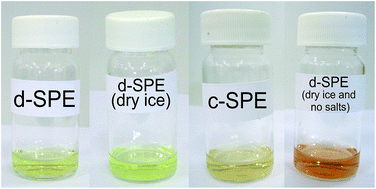Evaluation of dispersive and cartridge SPE clean-up procedures using the modified QuEChERS method for the analysis of pesticides in strawberries
Abstract
A comparison of dispersive and cartridge solid-phase extraction, d-SPE and c-SPE, respectively, for the clean-up step using the modified QuEChERS (quick, easy, cheap, effective, rugged and safe) method, followed by ultra-high performance liquid chromatography coupled with diode array detection (UHPLC-DAD) was carried out for the determination of pesticide residues in strawberries. Dry ice was used in the experiments for the evaluation of different temperatures. The efficiency of liquid–liquid partitioning step without salts was also evaluated. In all the experiments, the sorbent used in the clean-up step was primary secondary amine (PSA), and the evaluation of the sample preparation was made by the physical aspect of the final extract, the chromatographic profile, the recovery, the amounts of co-extractives in the matrix, which were determined by gravimetric measurements, and the matrix effect. A good clean-up procedure contributes to a longer lifetime of the chromatographic column and also for the entire system, and it also leads to better detectability for the developed method. Results showed that all the sample preparation methods were efficient for multiresidue pesticide analysis in this complex matrix, in which analytes with different physicochemical characteristics at low concentrations are present. The recovery results were in the range of 70–120%, and the coefficients of variation were ≤20% for most of the pesticides, as recommended for these analyses. The clean-up of the strawberry extracts was more efficient with the use of d-SPE at ambient temperature, considering the higher recoveries of the pesticides and better clean-up by removal of interferences; moreover, it was faster, easier and less expensive.


 Please wait while we load your content...
Please wait while we load your content...